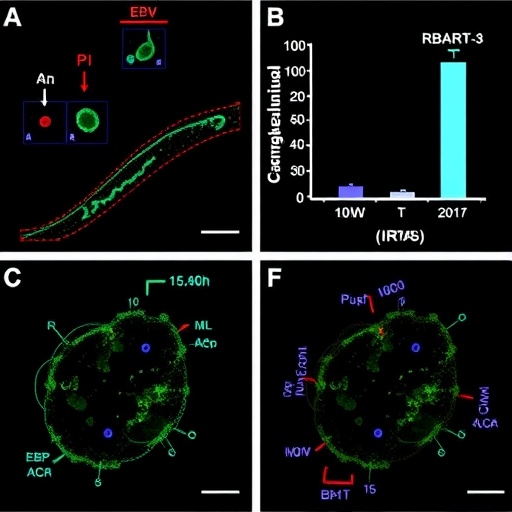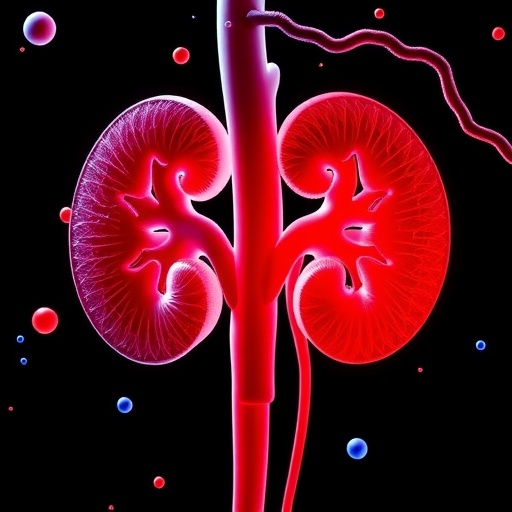The intricate relationship between viruses and cancer has long captivated researchers, providing crucial insights into the mechanisms of oncogenesis. Among the plethora of oncoviruses, Epstein-Barr virus (EBV) stands out for its duality: it can either promote cellular proliferation and survival or remain latent without causing harm. The most recent study by Yang, Han, and Zeng explores a novel viral mechanism that sheds light on EBV’s role in gastric cancer, specifically through the action of miR-BART19-3p. Their findings could have transformative implications for understanding how this oncovirus aids in the progression of malignancies associated with it.
The research presented by this team delves into the multifunctional microRNAs encoded by EBV, which play pivotal roles in modulating host cellular pathways. miR-BART19-3p emerges as a particularly potent player, demonstrating its ability to promote the growth of EBV-associated gastric cancer cells. This microRNA exploits various molecular pathways, showcasing the sophistication with which viral pathogens can manipulate host cellular environments to their advantage.
At the molecular level, GADD45B has been identified as a significant target of miR-BART19-3p. GADD45B is known for its role in various cellular processes, including stress responses and apoptosis. By inhibiting GADD45B, miR-BART19-3p effectively destabilizes the cellular mechanisms that would normally lead to cell cycle arrest or programmed cell death. This disruption of regulatory pathways promotes uncontrolled cell growth, which is a hallmark of cancer progression.
The occurrence of EBV-associated gastric cancer raises intriguing questions about the pathogenesis of this disease. Gastric cancers themselves are a significant public health concern, particularly in regions where the prevalence of EBV infection is high. The findings of Yang and colleagues provide a molecular link between EBV infection and the aggressive characteristics observed in these tumors, suggesting that targeting miR-BART19-3p could hinder tumor growth and potentially lead to new therapeutic strategies.
Interestingly, the study also provides insights into the broader implications of the EBV lifecycle and its interaction with host immune responses. The hijacking of microRNA pathways by EBV can be understood as a sophisticated strategy to escape immune surveillance. By promoting proliferation through the downregulation of GADD45B, the virus not only fosters its own persistence but also diminishes the host’s ability to mount an effective antitumor response.
Furthermore, miR-BART19-3p’s role in EBV-associated gastric cancer emphasizes the importance of studying viral microRNAs in a broader oncological context. The intricate interplay between viral and host factors could unveil novel targets for therapeutic intervention. As the landscape of cancer treatment continues to evolve with advances in precision medicine, there is potential for microRNA-targeted therapies to be developed, focusing on disrupting the specific oncogenic pathways utilized by EBV.
In addition to its implications for treatment, this research highlights the need for rigorous screening processes in populations at high risk for EBV-related gastric cancer. By identifying individuals with elevated levels of miR-BART19-3p, it can be possible to stratify patients and tailor more personalized monitoring and treatment approaches. This could ultimately improve patient outcomes and reduce morbidity associated with late-stage diagnoses.
This work not only elucidates the direct molecular mechanisms facilitating EBV’s role in gastric cancer but also serves as a catalyst for further studies examining the complex interactions between various viral agents and host cellular mechanisms. It lays the groundwork for exploring other viral microRNAs that may have similar effects on different cancers. Such explorations could uncover a plethora of new targets within the realm of cancer biology.
The findings of Yang, Han, and Zeng significantly contribute to the existing literature on EBV, further enriching our understanding of its oncogenic potential. This study underscores the delicate balance between host defense and viral persistence, emphasizing a need for more comprehensive research into the role of viral factors in human malignancies.
As the scientific community continues to uncover the complexities of the virus-cancer relationship, the work undertaken by these researchers emphasizes the critical importance of interdisciplinary approaches. Integrating virology, oncology, and molecular biology will allow for deeper insights into the mechanisms of cancer development and progression, ultimately guiding innovative therapeutic strategies designed to combat these diseases.
This exploration of EBV’s role in gastric cancer exemplifies the significance of ongoing virus-related cancer research. As our understanding deepens, we can hope to uncover additional mechanisms, actionable insights, and therapeutic possibilities that will improve the prognosis for patients battling EBV-associated malignancies without neglecting the implications for global health in regions endemic with EBV.
The implications of the findings extend to the potential development of novel biomarkers, which could facilitate earlier detection of EBV-associated gastric tumors. The identification of specific microRNAs like miR-BART19-3p not only aids in understanding tumor biology but also paves the way for new screening protocols that could significantly impact treatment timelines and patient outcomes.
The future of cancer therapy looks promising with the potential of microRNA-based interventions on the horizon. As ongoing clinical trials assess the efficacy of such approaches, the excitement surrounding targeted therapies continues to mount. The innovative work by Yang and colleagues injects fresh momentum into this field of research, fostering hope for new strategies to thwart EBV and its associated pathologies.
In conclusion, the research conducted by Yang, Han, and Zeng represents a critical step in elucidating how EBV utilizes microRNAs to promote gastric cancer proliferation. By targeting GADD45B, miR-BART19-3p alters cellular dynamics in a way that is detrimental to the host but beneficial to the virus. The study’s findings not only enrich the scientific discourse on viral oncogenesis but also open avenues for therapeutic development and preventive measures tailored to the unique challenges posed by EBV-associated cancers.
This sophisticated interplay of viral and cellular mechanisms warrants further investigation and provides a compelling narrative for subsequent research endeavors focusing on viral microRNAs in oncology. As the quest for innovative cancer therapies continues, studies like this illuminate paths that could redefine our understanding of virus-induced cancers and their treatment modalities.
Subject of Research: The role of Epstein-Barr virus-encoded microRNAs in gastric cancer proliferation.
Article Title: Epstein-Barr virus-coded miR-BART19-3p promotes proliferation of EBV-associated gastric cancer by inhibiting GADD45B.
Article References:
Yang, J., Han, Y., Zeng, B. et al. Epstein-Barr virus-coded miR-BART19-3p promotes proliferation of EBV-associated gastric cancer by inhibiting GADD45B.
J Transl Med 23, 956 (2025). https://doi.org/10.1186/s12967-025-06955-9
Image Credits: AI Generated
DOI: 10.1186/s12967-025-06955-9
Keywords: Epstein-Barr virus, miR-BART19-3p, gastric cancer, GADD45B, oncogenesis, microRNA, targeted therapy.
Tags: cancer research breakthroughscellular apoptosis modulation in cancerEBV and malignancy relationshipsEpstein-Barr virus role in gastric cancerGADD45B targeting by miR-BART19-3pgastric cancer growth factorsmicroRNA functions in cancer progressionmicroRNA pathways in oncologymiR-BART19-3p and EBV associationoncogenic mechanisms of EBVviral manipulation of host cellsviral oncovirus interactions





